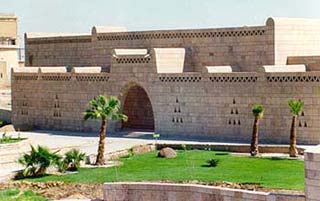|
 The Nubia Museum in Aswan
has been awarded the
prestigious International Aga Khan Award for Architecture The Nubia Museum in Aswan
has been awarded the
prestigious International Aga Khan Award for Architecture
One of the purposes of the Nubia Museum was to record Nubian
heritage and stress Nubian identity and pride. In this it has
been a resounding success. The museum compound, planned as a
cultural and civil centre with facilities for scholars, includes
halls for anthropological and ethnological studies and a
reference library. It is filled with Nubians from all walks of
life, who proudly show their heritage to their children, all
brought up and educated in Egypt. Groups of schoolchildren visit
at weekends
the Nubia museum would not only display salvaged artifacts
representing an endangered -- even lost -- culture, but would
provide a living memory of Nubia and its heritage. The museum
emphasizes the relationship that has linked Egypt and Nubia
throughout history.
The museum has been cited for an Award for its success in
integrating the past, present and future by creating in a single
building an educational institution dedicated to Nubian history,
a contemporary focus for the revival of Nubian culture and a
museum designed to promote and preserve cultural artifacts for
the future. Built to save the archaeological remains of the area
flooded by the Aswan High Dam, the museum was chosen for the
high quality of its construction materials and its attention to
detail. The building also successfully adapts local
architectural styles without imitating them. The appropriate
scale and choice of materials create a building that is
stylistically integrated into the city of Aswan. Nubian
monuments in the surrounding gardens have made the museum a
centre for community life. As an educational resource, both for
local residents and the international community, it saves the
Nubian culture for present and future generations
Aswan's Nubia Museum, which has been chosen from among 427
projects submitted to the jury in the current cycle for an Aga
Khan Award for Architecture The museum was one of nine to
receive the prize
The plans were drawn up by the late Egyptian architect Mahmoud
El-Hakim, who designed the delightful antiquities museum in
Luxor. The building, inspired by a combination of Nubian and
ancient Egyptian architecture, is surrounded by stepped terraces
built to harmonies with the rocky nature of the area. The museum
itself meshes with its surroundings and stands at a low
elevation so as not to distort the physical panorama. The
traditional Nubian style is clearly reflected in the design of
the façade, the door and windows, and especially in the vaulted
main entrance, a feature which dates from prehistoric times and
survives in Nubian houses today
The award is organised around a calendar spanning a three-year
cycle, and is governed by a Steering Committee chaired by the
Aga Khan. Prizes totaling up to $500,000 -- the largest
architectural award in the world -- are presented every three
years to projects selected by an independent Master Jury.
The Age Khan Award has completed continuous cycles of activity
since 1977, and documentation has been compiled on over 6,000
building projects located throughout the world. To date, the
Master Juries have identified 75 projects to receive awards. The
Eighth Award Cycle covers the period from1999 to 2001 K
Project Data
Clients: Nubian Antiquities Salvage Fund; Supreme Council of
Antiquities - Gaballah Ali Gaballah, Secretary General; Nubian
Museum - Ossama A W Abdel Meguid, Director.
Sponsors: UNESCO; income (International Council of Museums).
Architect: Mahmoud El-Hakim.
Consultants: Arab Bureau for Design and Technical Consultation -
Mohamad Yusri Abdel Khalik, Project Architect; Architectural
Team - Ahmed Kamal Abdel Fattah, Mohamed Tharwat, Lilly George.
Museum Display Designer: Pedro Ramírez Vásquez.
Landscape Architects: Dr Werkmeister & M Heimer Landscape
Architects - Hans Friedrich Werkmeister, Principal; Sites
International Landscape Architects - Laila El-Masry Stino,
Principal, with Maher Stino and Khaled Mostafa.
Contractors: El-Nasr General Contracting Company - Hassan Allam,
Construction; Silver Knight Exhibitions Ltd, Interiors.
Site Area: 50,000m2
Built Area: 10,110m2
Cost: EGP 57,000,000 (USD 15,000,000)
.This worthy prize, the Age Khan Award, will be shared by the
Nubia Museum, the Supreme Council of Antiquities, late architect
Mahmoud El-Hakim, and the Arab Bureau and Sites International
Landscape Architects
The Aga Khan Award for Architecture was established in 1977 by
his Highness the Aga Khan, the 4th hereditary Imam of the Shi'a
Ismaili Muslims. The aim was to enhance the understanding and
appreciation of Islamic culture as expressed through
architecture; the method was to seek out and recognise examples
of architectural excellence. The judges looked at aspects as
varied as contemporary design, social housing, community
improvement, development, restoration, re-use and conservation,
as well as landscaping and environmental issues. The Aga Khan
Award seeks to identify and encourage building concepts which
successfully address the needs and aspirations of societies in
which Muslims have a significant presence.
|